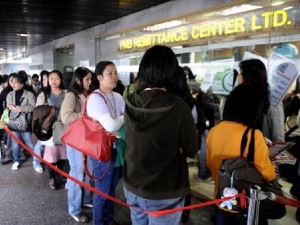Remittances rise on demand for OFWs

Filipino domestic helpers line up to send money at a remittance center in the central district of Hong Kong in this 2008 file photo. AFP/TED ALJIBE
Money sent home by overseas Filipino workers (OFW) continued to grow in June, boosted by sustained demand for skilled labor despite weak economic conditions abroad.
The bulk of cash remittances also came from workers working on contracts of at least one year—an indication of the expected sustainability of dollar inflows that support consumer spending in the country.
Data from the Bangko Sentral ng Pilipinas (BSP) showed cash remittances grew by 5.8 percent to $1.916 billion last June, accelerating from the 5.3-percent year-on-year growth rate the month before.
Following the trend in previous years, remittances for June were the highest so far for 2013. This brought the January to June total to $10.7 billion, up 5.6 percent from the first half of 2012.
“Remittances remained robust partly on the back of continued increase in demand for skilled Filipino labor,” the BSP said in a statement.
Article continues after this advertisementCiting data from the Philippine Overseas Employment Administration, BSP said workers deployed overseas in 2012 increased by 6.8 percent to 1.802 million from 1.687 million.
Article continues after this advertisementAbout 80 percent of these workers were land-based, while the rest were seafarers. Nearly a third or 32 percent were also newly-hired workers.
Majority of the new hires were employed as service, production, professional and technical workers in Saudi Arabia, the United Arab Emirates, Singapore, Hong Kong and Qatar.
BSP said the continued expansion of money transfer networks worldwide, which allows OFWs to send money efficiently to their families, supported remittances to the country.
“The steady stream of remittances also drew continued support from the efficient network of bank and non-bank remittance channels established worldwide and their expanding financial services to cater to the various needs of OFWs,” BSP said.